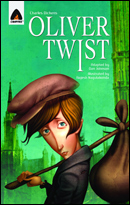Oliver Twist
 Oliver Twist, by Charles Dickens, adapted by Dan Johnson and Rakesh Nagulakonda
Oliver Twist, by Charles Dickens, adapted by Dan Johnson and Rakesh Nagulakonda
Published by Campfire
ISBN: 978-9-38002-856-9
As any good Dickens fan knows, the man liked words. A lot. In fact, and perhaps even more influential than his love of words, was the periodical, serial publication of Dickens' stories. He was paid by the word.
Thus, when I sat down to write this review, I kept asking myself: "Can any adaptation of Dickens' Oliver Twist really capture the depth of his original, lengthy novel?" The response I kept hearing from my inner-reading-self was, "Quality verse quantity, Katie." As an admittedly smitten reader of Dickens, I did not want to like this very thin version of Oliver Twist. But, to tell the truth, I do like it, and I see specific value in it for teachers and librarians.
The story of an orphaned Oliver Twist, which has always led critics to draw real life parallels to Dickens' own poor, working class upbringing, is complicated. For that reason, I strongly recommend this graphic novel adaptation to any teacher or librarian whose students are struggling to follow the lengthy and complex tale of Dickens' original Oliver Twist. I also recommend this graphic novel for any middle school or high school English Language Learners who are asked to read Oliver Twist. Campfire does an excellent job of visually identifying the characters and summarizing the story. Once to the story, the reader then encounters well-illustrated visuals that not only visually reinforce the original text, but also provide helpful reading momentum.
English Language Arts Elements of Story
Plot: Orphaned and alone, Oliver Twist seems destined to live a life of struggle and neglect. Not to mention the abuse he receives when he is unknowingly (and unwantingly) forced into a gang of thieves and common criminals. Will Oliver fall in line with the common lot of thieves and villains who try to convince him he is one of the gang, or will he somehow be saved or save himself from such a troubled life?
Setting: 19th century England
Major Characters: Oliver Twist, Mr. Bumble, Dodger, Fagin, Monks, Bill Sikes, Rose, Nancy, Mr. Brownlow
Themes: Identity, Relationships, Growing Up and/or Coming of Age, Fate and/or Destiny, Conflict and Resolution, Loyalty
Traditional and Contemporary Literary Pairing Suggestions: Charles Dickens' Oliver Twist and/or David Copperfieled, Kazu Kibuishi's Amulet series, Mark Twain's The Adventures of Huck Finn and/or The Adventures of Tom Sawyer, Jane Austen's Emma, Doug TenNapel's Earthboy Jacobus, J.D. Salinger's The Catcher in the Rye, Toni Morrison's Song of Solomon, Frank Norris' McTeague
Some Teaching Recommendations For Middle School & High School Readers
Suggested Alignment to the IRA /NCTE Standard(s):*
- standard #s correspond to the numbers used by IRA/NCTE
1. Students read a wide range of print and nonprint texts to build an understanding of texts, of themselves, and of the cultures of the United States and the world; to acquire new information; to respond to the needs and demands of society and the workplace; and for personal fulfillment. Among these texts are fiction and nonfiction, classic and contemporary works.
2. Students read a wide range of literature from many periods in many genres to build an understanding of the many dimensions (e.g., philosophical, ethical, aesthetic) of human experience.
3. Students apply a wide range of strategies to comprehend, interpret, evaluate and appreciate texts.
4. Students employ a wide range of strategies as they write and use different writing process elements appropriately to communicate with different audiences for a variety of purposes.
Suggested Guided Reading and Writing Lesson Plans
Guided Reading Lesson Plan
Before Reading: Ask readers to think about their own coming of age stories. What lessons have they learned so far? Who has supported them and helped them make good decisions? When have they felt supported, confused, and/or overwhelmed? What did they learn from such experiences? Keep a list of student ideas on the board.
During Reading: As students read, ask them to continue thinking along similar lines, but, this time, about Oliver: "People Who Support Oliver," "People or Times Oliver Feels Supported, Confused and/or Overwhelmed," "Lessons Oliver Learns as a Result."
Note: In order to help with comprehension, it is recommended that teachers make a handout of this simple three-column list for students.
After Reading: In order to prepare students for the upcoming Guided Writing Lesson Plan, ask them to review their lists and discuss them with a peer. Once students have had a chance to talk to their peers, engage them in a whole class discussion about everyone's lists. Encourage students to feel free to add to or revise their lists when needed.
Guided Writing Lesson Plan
Plan: On the board, write the fourth column again: "Lessons Oliver Learned As a Result." Following that title, write these directions: "Choose a specific lesson Oliver learns. Then, depending upon that choice, write a mini-essay that explains which people and/or situations led Oliver to learn that lesson." In order to create a writing workshop feeling in the room, encourage students to share their initial ideas together and with you.
Mini-Lesson: Complete this mini-essay lesson yourself and have your example ready to share with students.
Write: Students write.
Conference: During this time, teachers and librarians move around the room and consult with students as they compose their mini-essays.
Share: Ask the students to share their mini-essays with each other.
Katie Monnin, PhD, is an assistant professor of literacy at the University of North Florida and author of Teaching Graphic Novels: Practical Strategies for the Secondary ELA Classroom (2010) from Maupin House. To learn more about Teaching Graphic Novels or Katie Monnin, please go to this link: http://www.maupinhouse.com/monnin.php.


